by F.B. Peairs* (10/14)
Quick Facts…
- Two species of stalk borers attack field corn in Colorado: European corn borer, Ostrinia nubilalis; and southwestern corn borer, Diatraea grandiosella.
- Yield losses from either species vary with the number of larvae per plant and plant growth stage.
- Some naturally occurring biological controls, including insect predators, parasitic wasps, parasitic flies, and pathogens have been observed to affect both species in the field.
- Bt corn varieties are effective against both species.
| Table 1: How to tell the difference between the European and Southwestern corn borers. | ||
| European corn borer | Southwestern corn borer | |
| Distribution | Eastern Colorado, mostly in sprinkler irrigated corn in the northeast. | Southeast Colorado, rarely occurs as far north as Burlington. |
| Adults | Small, tan-to-gray moths. Wings marked with wavy brown lines. Wings fold flat. | White moths with unmarked wings. Wings fold tentlike around body. |
| Eggs | Found in masses of 15 – 30. Cream-colored, acquiring a black center as they near hatch. Usually on undersides of leaves. | Found in masses of 3 – 5. Develop three reddish stripes as they mature. Usually on upper leaf surfaces. |
| Larvae | Cream to pinkish colored larvae marked with distinct brown spots. | White larvae with distinct black spots.Overwintering larvae lose spots. |
| Damage | Tunnel in all parts of plant except roots. | Similar to European corn borer, except girdles lower stalk in fall. |
European Corn Borer
Description
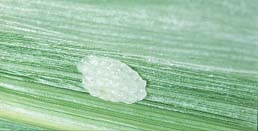
Figure 1: European corn borer egg mass. (Photo by S.D. Pilcher) |
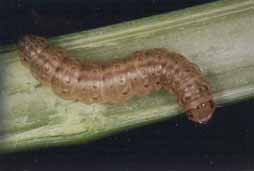
Figure 2: European corn borer larva. (Photo by F.B. Peairs) |
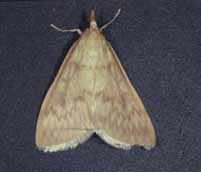
Figure 3: European corn borer female (left) and male (right) moths. (Photo by F.B. Peairs). |
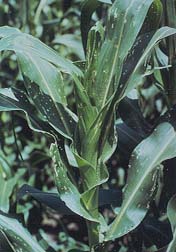
Figure 4: Feeding signs of the European corn borer. (Photo by S.D. Pilcher). |
European corn borer eggs are laid in masses of 15 to 30. The egg masses have a scaly, glossy white appearance (Figure 1). As the eggs mature, the black head capsules of the developing larvae become visible, which is known as the “blackhead stage.” European corn borer larvae are cream colored to pinkish caterpillars which are marked with small, round brown spots (Figure 2). The head capsule is dark or reddish brown. Fully developed larvae are about one inch (25 millimeters) in length. Male moths are distinctly darker and slightly smaller than the pale yellow female moth (Figure 3). The average adult wing span is about one inch. The forewings are buff colored with darker bands running in wavy lines.
Life History
European corn borer usually has two generations in Colorado, although a single generation may occur at higher elevations and a partial third generation has been observed on occasion. The two generations are quite different in damage and management because they occur at different stages in crop growth and development.
First generation. European corn borers overwinter as fully grown larvae in corn stalks and other plant residues. In early spring they pupate and emerge as moths during late May or early June. Adults fly at night but do not cause damage. On warm, calm, humid evenings in June, female moths fly from weedy or grassy margins into corn fields and lay eggs. Eggs are laid in masses on the underside of corn leaves, usually near the midrib. Once an egg mass reaches the blackhead stage, hatching will generally occur within 36 hours. Survival is poor on small plants (less than 18 inches). Larvae require from four to six weeks to complete development. Mature larvae pupate within the corn stalk. The second flight of moths emerges from mid-July to early August to lay the eggs of the second generation.
Second generation. Female summer moths prefer to lay eggs in corn that is tasseling and in the green silk stage. Later-maturing fields are more attractive to egg-laying moths than fields approaching maturity. These larvae usually overwinter and do not pupate until the following spring.
Damage
Newly hatched, first generation larvae feed first on the leaf near where they hatched. As the larvae grow they move to the whorl or leaf sheath area and feed. When leaves emerge, the “shot hole” feeding signs (Figure 4) in the leaves can be seen. Most of the mature larvae will bore into the stalks, feed, and finish development there. First generation damage includes leaf feeding and stalk boring.
Most second generation eggs are laid in the middle of the plant, on the undersides of the ear leaf and the three leaves above and the three leaves below the ear leaf. Newly hatched second generation larvae first feed on leaves and pollen in leaf axils and then move to leaf sheaths and collars, and ear tips. Partially grown larvae bore into the tassels, ear shanks, ears, and stalks. Second generation larvae cause ear damage (Figure 5); they tunnel in the shank (Figure 6); and feed on silks, kernels, and cobs. Signs of infestation include: dropped ears, broken shanks, stalk breakage, sawdust-like castings on leaves, and holes in the stalks.
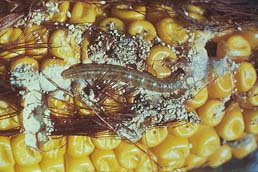
Figure 5: Ear damage caused by the European corn borer. (Photo by F.B. Peairs) |
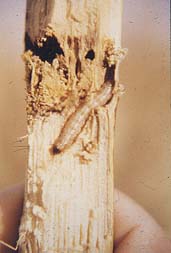
Figure 6: European corn borer tunneling in corn shank. (Photo by S.D. Pilcher) |
Yield losses depend on the number of larvae per plant and the stage of crop growth. Losses per borer, for infestation of one to six borers per plant, are given in Table 2 (taken from Mason, C. E. et al. 1996. European Corn Borer Ecology and Management. North Central Regional Extension Publication 327, Iowa State University, Ames, IA).
Management
Pathogens such as the fungus, Beauveria bassiana, and the protozoan, Nosema pyraustae, may weaken or kill European corn borers. Lady beetle larvae and adults and lacewing larvae feed on eggs and newly hatched larvae. A fly, Lydella thompsoni; and wasps including Eriborus terebrans, and Macrocentrus grandii, parasitize European corn borer larvae.
Planting and harvest dates may affect infestations and damage. Early planted crops and shorter season hybrids are more attractive to females in the first flight, which prefer taller corn. Later planted corn and longer season hybrids will be less mature and therefore more attractive to females during the second flight, which are attracted to flowering corn plants. The longer an infested crop remains in the field, the more losses will be incurred from lodging and ear drop. More heavily infested fields should be harvested first. Heavily infested fields should be harvested as soon as potential losses outweigh additional early harvest and drying expenses.
Some hybrids have useful resistance to the first generation European corn borers, which feed in the whorls and later enter the stalk. Some hybrids tolerate stalk and shank boring and thus are less likely to lodge or lose ears. Seed companies can provide information on these traits in their hybrids.
| Table 2: Losses per borer. | |
| Plant Growth Stage | % Grain Yield Loss per Borer per Plant |
| Early Whorl | 5.5 |
| Late Whorl | 4.4 |
| Pretassel | 6.6 |
| Pollen Shed | 4.4 |
| Blister | 3.0 |
| Dough | 2.0 |
There also are many hybrids, known as Bt corn hybrids, on the market that are resistant to corn borers through the insertion of a bacterial gene that causes the plant to produce an insecticidal protein. The level of European corn borer control achieved with Bt corn hybrids labeled for corn borers generally has been equal to or better than that obtained with insecticides.
Bt corn should be used only where the risk of European corn borer infestation is high. Colorado State University Extension entomologists recognize the following European corn borer risk areas within the Golden Plains area (Kit Carson, Phillips, Washington and Yuma counties) based on more than a decade of pest survey information. Pest survey data are insufficient to characterize European corn borer risk for other parts of the state.
Zone 1 (Burlington, Bonny Dam, Kirk) is characterized by heavy soils and consistently low light trap catches. Areas in this zone generally are not expected to have economic European corn borer infestations, although growers in the Kirk area experience occasional problems. Growers in Zone 1 should select well-adapted non-Bt corn hybrids, scout for insect pest problems, and apply appropriate insecticides if justified. The exception might be the Kirk area because it has a long (four to five week) second generation flight in some years, increasing the probability that late planted or late maturing varieties will experience economic infestation. Bt corn hybrids might be an appropriate choice for these situations.
Zone 2 (Yuma, Clarkville, Holyoke) has a high probability of late planting or late maturing varieties due to heavy soils. These areas also have a consistent history of a prolonged second generation flight that result in economic infestations. The Bt trait would be an appropriate choice for late planted or late maturing hybrids in these areas. The prolonged flight makes treatment decisions very difficult. The infestations accumulated over the season are economically significant, but not enough of the infestation occurs in any two week period to justify the use of an insecticide. The first generation flight is consistent enough in these areas that Bt hybrids might also be considered for early planting situations. Although there is not a consistent need for Bt hybrids in this zone, it will be important to consider resistance management requirements when selecting hybrids and their acreage allocation.
Zone 3 (Eckley, Wray, Wauneta) is characterized by light soils, relatively uniform crop maturity, and consistently large first and second generation European corn borer flights. Also, second generation flights typically extend over long periods of time. Economic infestations from either generation are likely and often both generations have to be treated in the same field. In addition, it frequently has been difficult to obtain adequate second generation control with a single insecticide application. The use of Bt corn hybrids are recommended for this area, regardless of planting date or maturity.
If you are not in one of the zones described above, take a look at your average expenditures for corn borer management (scouting, insecticides, application) and your average losses to corn borers over the last five years. Your annual total of management costs and crop value lost should be similar to the cost of switching.
Granules applied by ground and air, as well as some center-pivot applied liquids, have given the best first generation control results in university tests. Aerially-applied and center-pivot applied liquids have performed better than granules for control of second generation larvae in university tests. Monitor treated fields for spider mites as applications for control of second generation are often associated with mite outbreaks. See highplainsipm.org for available insecticide products.
Treatment Guidelines
The need to treat European corn borer can be determined by a simple method based on average Colorado conditions, or by a more complex method which takes into account treatment costs, individual field yields, and current market conditions. Incorrect treatment decisions, by either method, are more likely with second generation infestations because the second generation egg laying period, which can last up to four weeks, makes proper treatment timing very difficult. Try examining five sets of 20 plants per 50 acres of corn – fewer samples will increase the chance for incorrect treatment decisions.
By the simple method, chemical control of the first generation is economical when 25 percent of the plants have feeding damage and live larvae are present in the whorls (check five whorls for live larvae at each sample site). Once larvae have entered the stalk, control is impossible. Survival of second generation larvae is highest during pollination, so treatments should be considered when weekly scouting has an accumulated total of 25 percent of plants with egg masses. This percentage should be raised to at least 50 percent after pollination. If egg laying continues after the treatment, a second application may be justified. The complex method is described in the online High Plains Integrated Pest Management Guide (https://wiki.bugwood.org/HPIPM:Main_Page).
Southwestern Corn Borer
Description
Southwestern corn borer eggs (Figure 7) are laid in groups of three to five, and overlap each other slightly. They initially are creamy white but develop three reddish stripes as they near hatch. Larvae are dull white with dark brown to black spots forming a regular pattern along the body (Figure 8). These spots generally disappear in overwintering larvae (Figure 9). Fully grown larvae are from 1 to 1.25 inches long. Moths are white to pale yellow in color and about 3/4 inch long (Figure 10). The wings have no distinct markings and are held tentlike over the body.
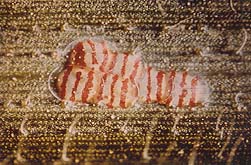
Figure 7: Southwestern corn borer eggs. (Photo by S.D. Pilcher) |
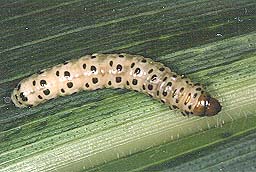
Figure 8: Southwestern corn borer larvae. (Photo by F.B. Peairs) |
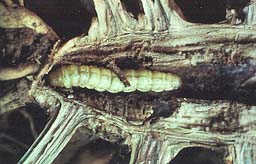
Figure 9: Southwestern corn borer overwintering larvae. (Photo by S.D. Pilcher). |
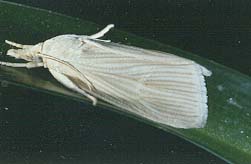
Figure 10: Southwestern corn borer moth. (Photo by J.L. Capinera). |
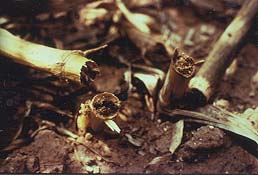
Figure 11: Southwestern corn borer lodging. (Photo by S.D. Pilcher). |
Life History
The southwestern corn borer and the European corn borer have similar life histories. Overwintering larvae pupate in the spring and emerge as adults about 10 days later. Adults are active primarily at night but can be found during the day under leaves. These moths lay eggs that produce the first generation of southwestern corn borers. Generally, eggs are laid on the upper surfaces of leaves. Larvae hatch and feed for four to six weeks in the whorls and stalks of the plant. After pupation, a second moth flight occurs. Eggs generally are laid on the upper leaf surfaces in the ear zone of tasseled plants. When second generation larvae have completed their development, they tunnel down to the base of the plant to prepare their overwintering site. Here they chew a groove around the inside of the stalk a few inches above the soil surface. Then they tunnel out a hibernation cell in the underground part of the crown of the corn plant, go through a molt in which they lose their spots, and finally, plug up the entrance to the cell.
Damage
First generation larvae feed in the whorls of young corn plants and, unlike European corn borer, do well on whorl stage plants of any age. This feeding may result in “dead heart,” due to the death of the growing tip. About half way through their development they bore into the stalk.
Young second generation larvae appear near tasseling and feed in the ears or leaf sheaths. Half-grown larvae of the second generation bore into the stalk. The stem girdling during preparation for overwintering weakens plants and makes them susceptible to lodging (Figure 11). Grain yield losses, exclusive of lodged or girdled plants, of about 30 percent have been recorded for plants infested with both first and second generation larvae.
Management
Management options are similar to those for European corn borer. Some general predators, such as lady beetles and lacewings, feed on southwestern corn borer eggs and larvae. Early planted corn may escape second generation damage. Crop rotation may help reduce yield losses. Cultural practices that promote strong healthy stalks help mitigate losses due to lodging. Early harvest can help minimize lodging and girdling losses. Fall and winter stalk destruction, on an area wide basis, can reduce overwintering populations.
Short season varieties often escape second generation damage. Bt corn hybrids labeled for corn borers are as effective against southwestern corn borer as they are against European corn borer.
Treatment Guidelines
Check corn for first generation egg masses and larvae from mid-May through June. Second generation should be scouted from mid-July through August. Consider chemical control if 25 percent of the plants have egg masses or newlyhatched larvae of either generation. The comments on chemical control of European corn borer, regarding application methods and spider mite concerns, also are valid for southwestern corn borer.
Interesting Web sites:
- Bt Corn Hybrid Info: www.colostate.edu/programs/lifesciences/TransgenicCrops/current
- High Plains Integrated Pest Management: https://wiki.bugwood.org/HPIPM:Main_Page
* F.B.Peairs, Colorado State University Extension entomologist and professor of entomology, bioagricultural sciences and pest management. 6/02. Revised 10/14.
Colorado State University, U.S. Department of Agriculture and Colorado counties cooperating. CSU Extension programs are available to all without discrimination. No endorsement of products mentioned is intended nor is criticism implied of products not mentioned.
Go to top of this page.





